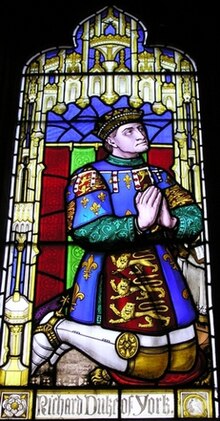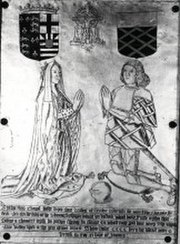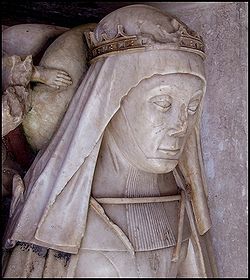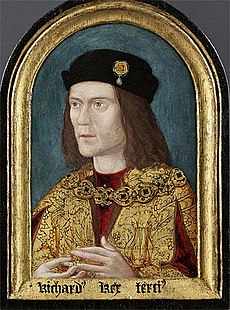He was the military genius with a better claim to
the throne than the King; she was the most beautiful woman of her generation.
Together they had thirteen children, seven of whom survived, two of which became Kings of England, two died in battle and one was executed for treason. Of her twenty-eight legitimate great-grandchildren, the most famous was the future Henry VIII.

 Cecily and Richard, Duke and Duchess of York
Cecily and Richard, Duke and Duchess of York
Cecily Neville came from a large family. Born in
1415, she was the youngest of fourteen children and a granddaughter of John of
Gaunt, son of Edward III. Born at Raby Castle, she became known to history as the “rose of
Raby” for her beauty and “proud Cis,” perhaps as a reminder of the time when she and her husband held a
court at Fotheringhay Castle which rivalled that of the King in magnificence.
She was married at the age of fourteen to Richard, Duke of York, to whom she
had been betrothed at the age of nine. Four years her elder, Richard was the
great-great grandson of Lionel, Edward III’s second son, but his claim to the
throne came through the female line. His own family was small, with only one
sister surviving to adulthood.
Richard and Cecily were of age to consummate their
marriage in 1429. He was eighteen and she had reached the traditional age of
consent, although it was sometimes considered advisable for teenage girls to
wait a few years to prevent the physical damage that early pregnancy could do,
especially if they were petite. In the event though, the couple’s first child
was not conceived for almost nine years. Joan arrived in August 1438,
suggesting that they may have waited for a while before sleeping together, or for Cecily's menarche, but
then experienced reduced fertility of some kind. Presumably, for a young aristocratic
couple, the need to provide an heir to the Yorkist title would have led them to
attempt to start a family way before Joan’s arrival. Marriage and motherhood were
what defined the secular medieval woman and by this point, Richard was already in
his late 20s. As was the case with many medieval children, little Joan did not
survive, either dying at birth or soon after.
 Anne of York, b. August 1439, pictured with her second husband, Thomas St Leger
Anne of York, b. August 1439, pictured with her second husband, Thomas St Leger
By November the same year, 1438, Cecily was pregnant
again. A second daughter, Anne, arrived the following August at the family home
at Fotheringhay and appeared strong and healthy. She would be married at the age
of seven to Henry Holland, Duke of Exeter and bear him a child around the age of sixteen, although his Lancastrian leanings
would later lead to their divorce. Nine months after the birth of Anne, Cecily
was pregnant for a third time. In February 1441, she was delivered of a son,
named Henry, who died hours after birth. At twenty-six, Cecily had then been
married for twelve years and only had one live child to show for it. Her
children’s survival rate of one in three was not untypical of the times but it
must have been disheartening at the least for the young couple. However, Cecily
now appeared to have no trouble conceiving. Five months later, she was pregnant
again. The circumstances of her next child's birth would prove controversial and impact on the course of English history and the lives of her grandchildren.
The Duke and Duchess of York had left Fotheringhay following
the death of Henry, in favour of Rouen. York had been appointed
Governor General of France, overseeing the many territories taken as part of
the Hundred Years’ War. Edward’s birthdate of 28 April 1442 indicates that he was
conceived around the end of July 1441. Some sources have suggested that Richard
and Cecily were apart during this time, although the actual distance between
them was not insurmountable and their individual itineraries do not exclude the
possibility of marital visits. Records in Rouen Cathedral state when Richard left but not Cecily's comings and goings; as they were in their late twenties and had no surviving son, they may well have taken every opportunity to be together. It would not have been too difficult for her to travel to see him or for them to have met at some convenient midpoint. Less than half a day's ride would have taken her to Pontoise, where York was on campaign.
Equally, babies can arrive as late as two weeks or more and deducing conception dates was (and still is) not an exact science. Pregnancies today that run up over their due date are induced after a fortnight but in the past, women would simply have had to sit it out. It is quite likely that Cecily experienced one of these forty two week gestations and may have had a labour that was difficult for her and her child. These dates are consistent with Edward being conceived before York left Rouen, or on a return visit, or that Cecily visited him on campaign, as her movements are not recorded. Later rumours , most likely the inventions of the Earl of Warwick, would seek to discredit Edward by
suggesting he was the result of a liaison his mother had had with a French
archer named Blancbourgne. This is to underestimate Cecily Neville.
As a woman of her time, Cecily was well aware of the importance of
legitimacy and inheritance; she had far too much to lose by having a casual
fling. Loyalty and pride seem to have been her trademarks. These are particularly incompatible with the suggestion of infidelity and although the rumour was briefly resurrected in 1483, there was never any other suggestion that she had strayed. The slur was politically motivated. Women were not assailable by the usual methods men adopted to topple each other; they could not be fought in battle and were rarely arrested or imprisoned unless they had clearly transgressed certain boundaries. To attack a high born women, the best tools were rumours and suggestions that blackened her good name. Thus, witchcraft, immorality, unladylike behaviour and illegitimacy were the weapons of necessity.
Also, Cecily had lost an infant son only the previous year. Any reputed adultery would have taken place within months of this loss. If there was any question of the infant Edward being in danger when he arrived, she would have followed contemporary protocol in having him baptised at once, often by a midwife in the bedroom itself. Babies who were considered to be at risk of not surviving were sometimes even baptised as they emerged, so any protruding limb or the crowning head may receive the blessing, such was the significance of the act for the child's immortal soul. Early maps of Rouen Castle, where Edward was born, show that there were three chapels within the walls, one of which was beside the apartments the Yorks would have occupied. It seems likely that Edward was baptised in this manner. Equally, when he was three, his father entered negotiations with the King of France, Charles VII, for a marriage between Edward and one of his daughters. There would have been no question of a royal wife for the boy, if there had been any contemporary doubts about his legitimacy. The rumours about Edward's conception are simply that, politically motivated rumours and they need to be recognised as such.

Edward IV b. April 1442
Four months
after Edward’s birth, Cecily was pregnant again. This represented her swiftest
conception interval yet and must have taken a physical toll, as she had only
just recovered from the latest arrival. Her next child, as son named Edmund,
also arrived in Rouen in May 1443. He would die in 1460, at the age of seventeen,
fighting alongside his father, who also fell at the Battle of Wakefield. Cecily
and Richard resumed sexual relations quickly. Contemporary practices advised
abstinence until a woman was churched, usually a month after giving birth,
which also helped guard against another pregnancy beginning before her body had
healed. Barely eight weeks after Edmund’s arrival in May, though, Cecily had
conceived again. By the end of July 1443 she was expecting the daughter who
arrived on April 22, 1444, whom they named Elizabeth. She would marry John de
la Pole, Duke of Suffolk, before her fourteenth birthday and go on to bear him
at least eleven children, some of whom would later pose a threat to the succession for their Tudor relations.

Elizabeth b. April 1444
Cecily was
now the mother of four small children, two boys and two girls. Approaching her
thirtieth birthday, she had provided her husband with the necessary heir and
spare, as well as two daughters whose marriages would prove useful in terms of
forging more dynastic links. It was after the birth of Elizabeth that they
relocated back to England, arriving in October 1445. By the time she was settling back in at
Fotheringhay Castle, Cecily was pregnant again after an interval of
sixteen months. Her first child born on English soil again, proved to be a
girl, Margaret, who was delivered in May 1446 and went on to marry the Duke of
Burgundy, although she had no children of her own. Once again, Cecily conceived
quickly. Five months had elapsed since her last birth, giving her just enough
time to recover before the process began again. She bore a short-lived son,
William, in July 1447, conceived again after seven months and had John in
November 1448, although he also died. By now she had had nine children in the
space of ten years, and, setting aside the atypical interval of sixteen months
between Elizabeth and Margaret, her average conception period was six months.

Margaret b. May 1446
Less than
three months later, Cecily was expecting again. When Richard took up his appointment
of Lieutenant of Ireland, she went with him to Dublin, even though she was then
five months pregnant. On October 21, George was born in the twelfth century Castle
there, giving his parents a third surviving son. As Duke of Clarence, he would
father four children of his own, two of whom lived to adulthood, before he was
executed for treason by his elder brother Edward. Both his surviving offspring would also be executed as dynastic threats, his son Edward of Warwick, in 1499 by henry VII and his daughter, Margaret Pole, by Henry VIII in 1541. Soon after George’s first birthday, Richard
and Cecily returned to England with their family. Civil unrest called for the
Duke of York’s presence and their next child may have been conceived on their
return home. A short-lived boy, Thomas, was born at some point in 1451 and died
young, although the precise length of his life is unknown. Soon Cecily was
pregnant again, for the twelfth time, with her most controversial child yet.

George b. October 1449
A boy was
born to the Duchess in October 1452 at Fotheringhay Castle. Later chroniclers
claimed she had been pregnant for two years, that he was breech-born, sickly, deformed
and with teeth. Yet the arrival of Richard was probably no less difficult than
his mother’s previous eleven deliveries, although she anticipated the familiar discomfort in a letter to Margaret of Anjou. Taking after his father in appearance,
the little boy was wiry and dark-haired in comparison with his taller,
(supposedly) golden-haired brothers. (Portraits show Edward with dark hair; paint can darken but golden hair was often a convention reserved for royalty). When he later came to the throne as Richard III, it was
under circumstances that still excite debate today. With the death of his elder
brother Edward in 1483, rumours of the late King’s illegitimacy cast the claim
of his own sons into doubt. The Princes in the Tower, twelve-year-old Edward V
and his ten-year-old brother, Richard, disappeared that summer, under their
uncle’s custody, and shortly after, he was proclaimed King. His reign was short
though, with his only legitimate son predeceasing him a year before he met a
violent death on the battlefield at Bosworth.
 Richard b. October 1452
Richard b. October 1452
Following the birth of
Richard, Cecily had one more child, a girl named Ursula. She was conceived soon
after little Richard’s second birthday, born in July 1455 and died young. Out of thirteen
pregnancies, spanning seventeen years, the Duke and Duchess of York were left
with seven children, giving them a survival rate of just over fifty percent.
Those pregnancies are well documented in a surviving poem from the Clare Roll
and it is unlikely that she conceived again after 1455, when, at the age of
forty, she probably underwent the menopause. Five years after this she was
widowed and did not remarry.
The dates of
Cecily’s deliveries help build a picture of the fertility of a late medieval
aristocratic couple. The long period before her first conception is unusual but
following that, the intervals between her children indicate regular sexual
relations, which, on several occasions, were even resumed very quickly
following the act of birth. This also suggests that Cecily, in common with her noble
peers, did not breastfeed, which would have given her some contraceptive
protection. The survival rate of her infants is also fairly typical and those
who did not make it were not necessarily those conceived with greatest speed. It is also interesting, and fairly unusual, that those of her children who did not survive appear to have been either still born or died soon after birth; Cecily does not appear to have had infants succumb as toddlers or older, as was often the case with illness, accident or disease. Her daughter-in-law Elizabeth Wydeville, wife of Edward, would lose three children to illness before they reached maturity and two others to violence. Her eldest daughter, Elizabeth of York and her daughter Margaret, Queen of Scotland and daughter-in-law Catherine of Aragon, would suffer equal or higher rates of infant mortality, losing children of all ages. As a
pattern of fertility, Cecily's life gives an insight into sexual practices and the lifecycle of one individual, both typical and atypical. Perhaps she was a late developer; her menarche may
not have arrived until her late teens, or else was erratic but the comparatively late
arrival of her first child may also have delayed her menopause, which tended to
arrive earlier in women of the era whose childbearing years began early.
Cecily
outlived her husband by thirty-five years. She saw her son Edward become King,
followed by Richard, who fell in battle. Then, the Tudor conqueror married her
granddaughter Elizabeth and had children who would inherit the throne. She had
twenty-eight legitimate grandchildren and outlived all her own offspring except
for two. Before she died in 1495, she saw the arrival of her great grandson,
the future Henry VIII.




